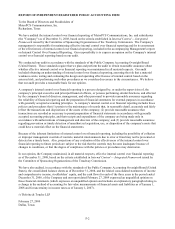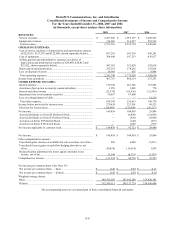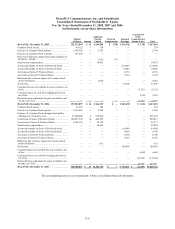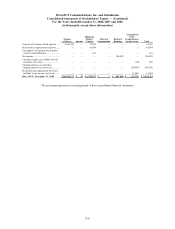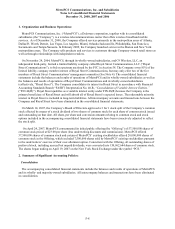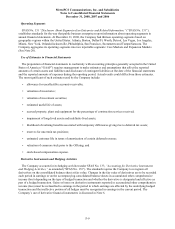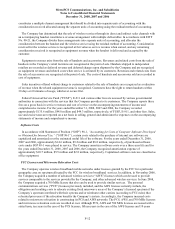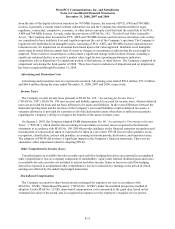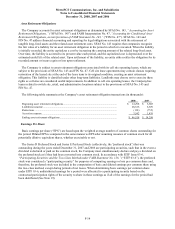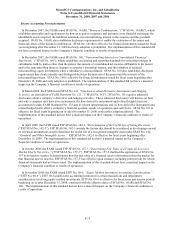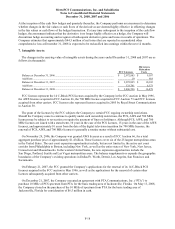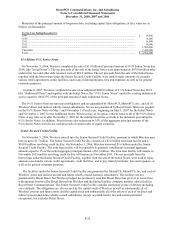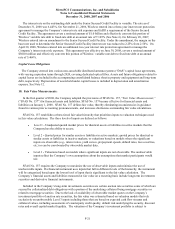Metro PCS 2008 Annual Report Download - page 113
Download and view the complete annual report
Please find page 113 of the 2008 Metro PCS annual report below. You can navigate through the pages in the report by either clicking on the pages listed below, or by using the keyword search tool below to find specific information within the annual report.
MetroPCS Communications, Inc. and Subsidiaries
Notes to Consolidated Financial Statements
December 31, 2008, 2007 and 2006
F-11
interest, up to fifteen years for capital lease assets, three to seven years for office equipment, which includes
computer equipment, three to seven years for furniture and fixtures and five years for vehicles. Leasehold
improvements are amortized over the shorter of the remaining term of the lease and any renewal periods reasonably
assured or the estimated useful life of the improvement. Maintenance and repair costs are charged to expense as
incurred. The Company follows the provisions of SFAS No. 34, “Capitalization of Interest Cost,” with respect to its
FCC licenses and the related construction of its network infrastructure assets. Capitalization commences with pre-
construction period administrative and technical activities, which includes obtaining leases, zoning approvals and
building permits, and ceases at the point in which the asset is ready for its intended use, which generally coincides
with the market launch date. For the years ended December 31, 2008, 2007 and 2006, the Company capitalized
interest in the amount of $64.2 million, $34.9 million and $17.5 million, respectively.
Impairment of Long-Lived Assets
The Company assesses potential impairments to its long-lived assets, including property and equipment, when
there is evidence that events or changes in circumstances indicate that the carrying value may not be recoverable. An
impairment loss may be required to be recognized when the undiscounted cash flows expected to be generated by a
long-lived asset (or group of such assets) is less than its carrying value. Any required impairment loss would be
measured as the amount by which the asset’s carrying value exceeds its fair value and would be recorded as a
reduction in the carrying value of the related asset and charged to results of operations.
Restricted Cash and Investments
Restricted cash and investments consist of cash deposited in escrow accounts, money market instruments and
short-term investments. In general, these investments are pledged as collateral against letters of credit used as
security for payment obligations and are presented as current or non-current assets based on the terms of the
underlying letters of credit.
Long-Term Investments
The Company accounts for its investment securities in accordance with SFAS No. 115, “Accounting for Certain
Investments in Debt and Equity Securities.” At December 31, 2008, all of the Company’s long-term investment
securities were reported at fair value. Due to the lack of availability of observable market quotes on the Company’s
investment portfolio of auction rate securities, the fair value was estimated based on valuation models that rely
exclusively on unobservable inputs including those that are based on expected cash flow streams and collateral
values, including assessments of counterparty credit quality, default risk underlying the security, discount rates and
overall capital market liquidity.
Declines in fair value that are considered other-than-temporary are charged to earnings.
The valuation of the Company’s investment portfolio is subject to uncertainties that are difficult to predict.
Factors that may impact the Company’s valuation include changes to credit ratings of the securities as well as the
underlying assets supporting those securities, rates of default of the underlying assets, underlying collateral values,
discount rates, counterparty risk and ongoing strength and quality of market credit and liquidity (See Note 5).
Revenues and Cost of Service
The Company’s wireless services are provided on a month-to-month basis and are paid in advance. Revenues
from wireless services are recognized as services are rendered. Amounts received in advance are recorded as
deferred revenue. Long-term deferred revenue is included in other long-term liabilities. Cost of service generally
includes the direct costs of operating the Company’s networks.
The Company follows the provisions of Emerging Issues Task Force (“EITF”) No. 00-21, “Accounting for
Revenue Arrangements with Multiple Deliverables,” (“EITF No. 00-21”). Under the provisions of EITF No. 00-21,
arrangements that involve the delivery or performance of multiple products, services and/or rights to use assets



